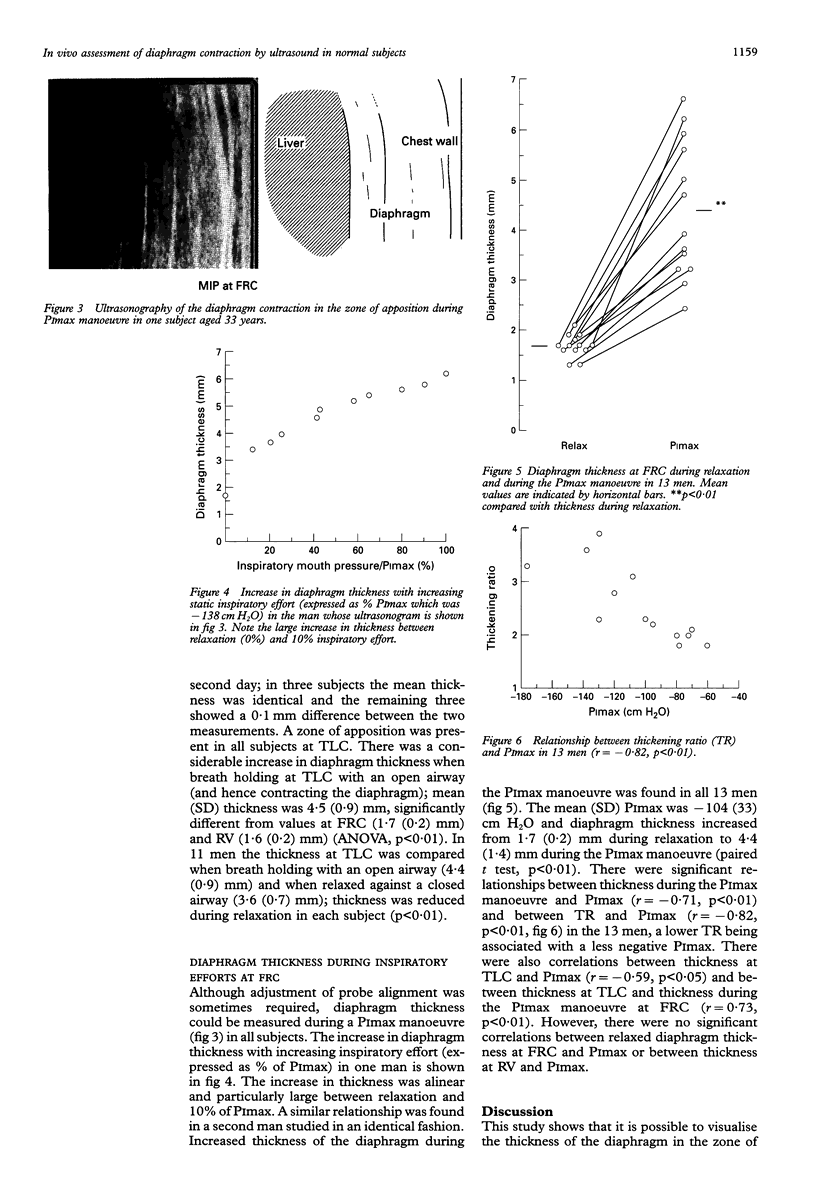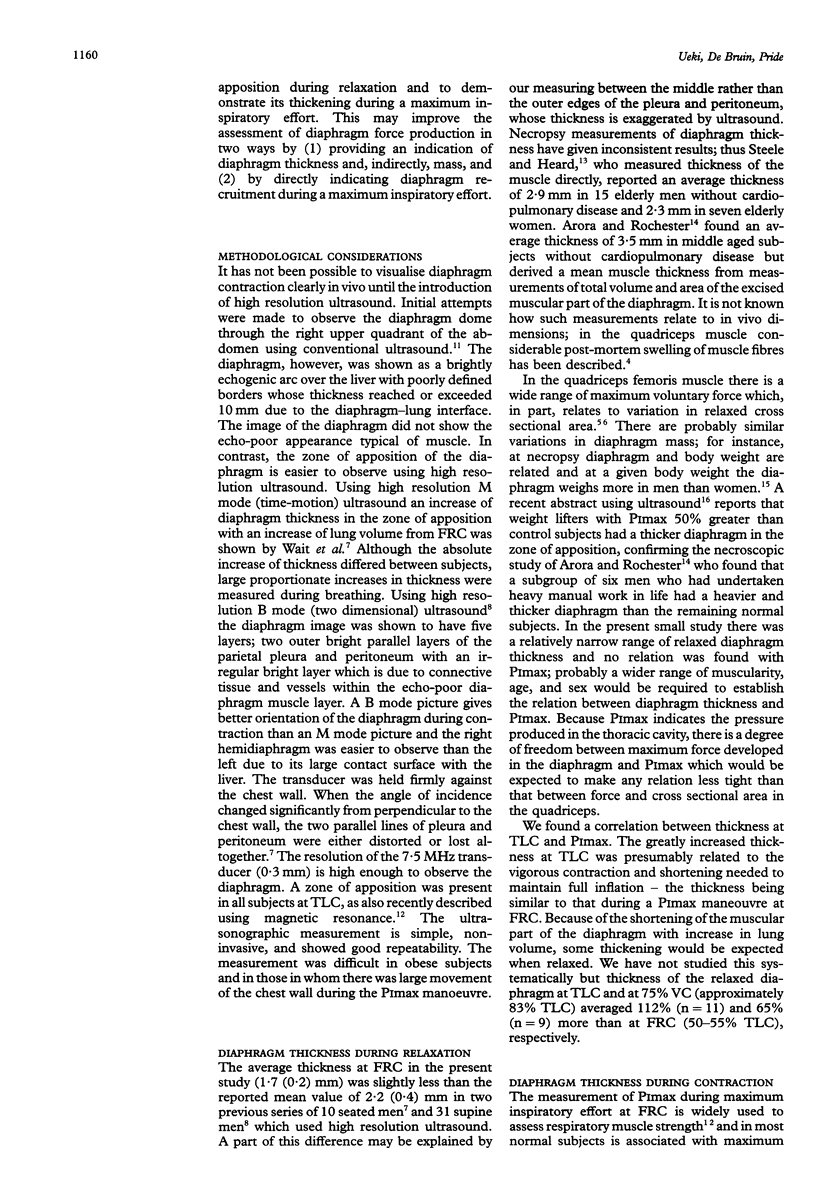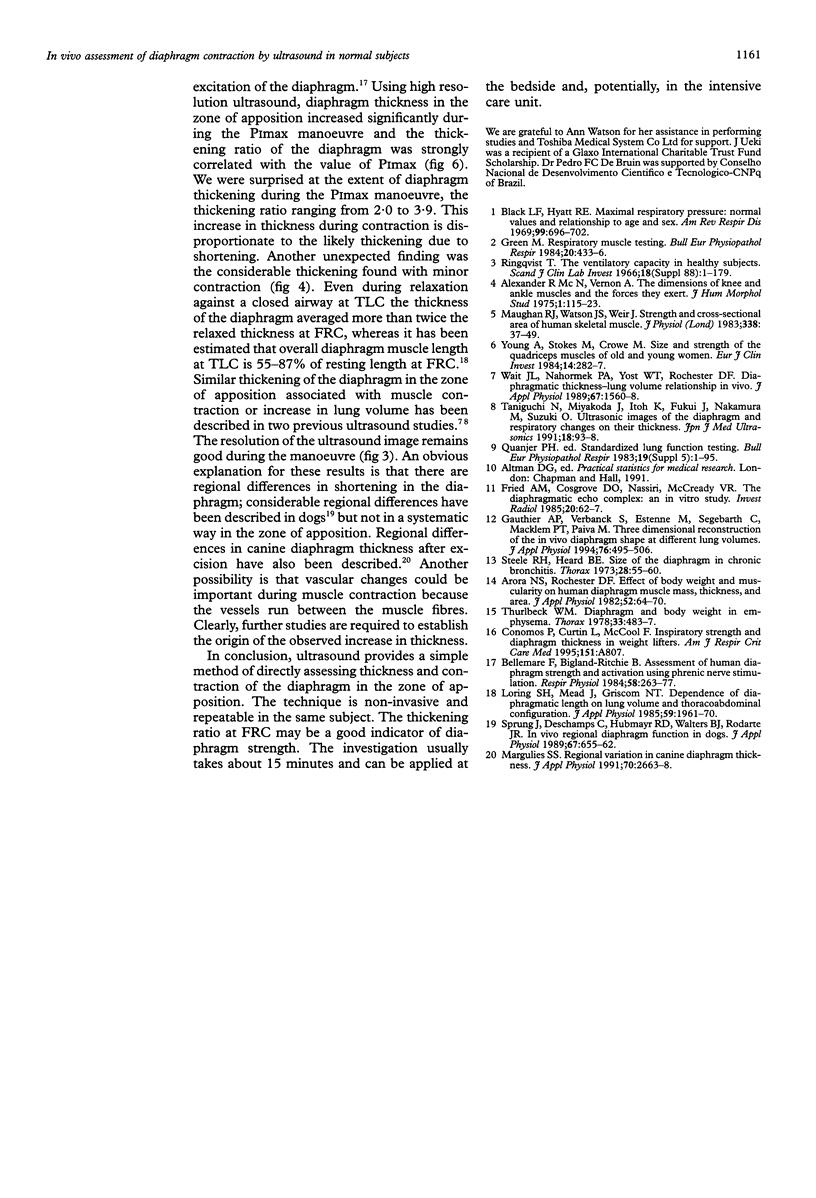Abstract
BACKGROUND--Ultrasound allows observation of the thickness of the diaphragm in the zone of apposition in vivo during relaxation and maximum inspiratory efforts. METHODS--Changes of diaphragm thickness were studied by B mode (two dimensional) ultrasound in 13 healthy men aged 29-54 years in the seated position. A high resolution 7.5 MHz ultrasound transducer was held perpendicular to the chest wall in the line of a right intercostal space between the anteroaxillary and mid-axillary lines to observe the diaphragm in the zone of apposition 0.5-2 cm below the costophrenic angle. The changes of thickness were observed while breath holding at total lung capacity (TLC), functional residual capacity (FRC), and residual volume (RV). At FRC the thickness while relaxing against a closed mouthpiece and during a maximum inspiratory mouth pressure (PImax) manoeuvre was recorded. The thickening ratio (TR) was calculated as TR = thickness during PImax manoeuvre/thickness while relaxing. RESULTS--Mean (SD) thickness was 4.5 (0.9) mm at TLC, 1.7 (0.2) mm at FRC, and 1.6 (0.2) mm at RV. During the PImax manoeuvre at FRC mean thickness increased from 1.7 (0.2) mm during relaxation to 4.4 (1.4) mm, while mean PImax and TR were -104 (33) cm H2O and 2.6 (0.7), respectively. There was a high degree of correlation between TR and the pressure achieved during the maximum inspiratory manoeuvre (r = -0.82). CONCLUSIONS--Ultrasound provides a non-invasive assessment of diaphragm thickness with change of lung volume and during the PImax manoeuvre which should prove useful in assessing diaphragm mass and contraction in respiratory and muscle disease.
Full text
PDF




Images in this article
Selected References
These references are in PubMed. This may not be the complete list of references from this article.
- Arora N. S., Rochester D. F. Effect of body weight and muscularity on human diaphragm muscle mass, thickness, and area. J Appl Physiol Respir Environ Exerc Physiol. 1982 Jan;52(1):64–70. doi: 10.1152/jappl.1982.52.1.64. [DOI] [PubMed] [Google Scholar]
- Bellemare F., Bigland-Ritchie B. Assessment of human diaphragm strength and activation using phrenic nerve stimulation. Respir Physiol. 1984 Dec;58(3):263–277. doi: 10.1016/0034-5687(84)90003-3. [DOI] [PubMed] [Google Scholar]
- Black L. F., Hyatt R. E. Maximal respiratory pressures: normal values and relationship to age and sex. Am Rev Respir Dis. 1969 May;99(5):696–702. doi: 10.1164/arrd.1969.99.5.696. [DOI] [PubMed] [Google Scholar]
- Gauthier A. P., Verbanck S., Estenne M., Segebarth C., Macklem P. T., Paiva M. Three-dimensional reconstruction of the in vivo human diaphragm shape at different lung volumes. J Appl Physiol (1985) 1994 Feb;76(2):495–506. doi: 10.1152/jappl.1994.76.2.495. [DOI] [PubMed] [Google Scholar]
- Green M. Respiratory muscle testing. Bull Eur Physiopathol Respir. 1984 Sep-Oct;20(5):433–435. [PubMed] [Google Scholar]
- Loring S. H., Mead J., Griscom N. T. Dependence of diaphragmatic length on lung volume and thoracoabdominal configuration. J Appl Physiol (1985) 1985 Dec;59(6):1961–1970. doi: 10.1152/jappl.1985.59.6.1961. [DOI] [PubMed] [Google Scholar]
- Margulies S. S. Regional variation in canine diaphragm thickness. J Appl Physiol (1985) 1991 Jun;70(6):2663–2668. doi: 10.1152/jappl.1991.70.6.2663. [DOI] [PubMed] [Google Scholar]
- Maughan R. J., Watson J. S., Weir J. Strength and cross-sectional area of human skeletal muscle. J Physiol. 1983 May;338:37–49. doi: 10.1113/jphysiol.1983.sp014658. [DOI] [PMC free article] [PubMed] [Google Scholar]
- Ringqvist T. The ventilatory capacity in healthy subjects. An analysis of causal factors with special reference to the respiratory forces. Scand J Clin Lab Invest Suppl. 1966;88:5–179. [PubMed] [Google Scholar]
- Sprung J., Deschamps C., Hubmayr R. D., Walters B. J., Rodarte J. R. In vivo regional diaphragm function in dogs. J Appl Physiol (1985) 1989 Aug;67(2):655–662. doi: 10.1152/jappl.1989.67.2.655. [DOI] [PubMed] [Google Scholar]
- Standardized lung function testing. Report working party. Bull Eur Physiopathol Respir. 1983 Jul;19 (Suppl 5):1–95. [PubMed] [Google Scholar]
- Steele R. H., Heard B. E. Size of the diaphragm in chronic bronchitis. Thorax. 1973 Jan;28(1):55–60. doi: 10.1136/thx.28.1.55. [DOI] [PMC free article] [PubMed] [Google Scholar]
- Thurlbeck W. M. Diaphragm and body weight in emphysema. Thorax. 1978 Aug;33(4):483–487. doi: 10.1136/thx.33.4.483. [DOI] [PMC free article] [PubMed] [Google Scholar]
- Wait J. L., Nahormek P. A., Yost W. T., Rochester D. P. Diaphragmatic thickness-lung volume relationship in vivo. J Appl Physiol (1985) 1989 Oct;67(4):1560–1568. doi: 10.1152/jappl.1989.67.4.1560. [DOI] [PubMed] [Google Scholar]
- Young A., Stokes M., Crowe M. Size and strength of the quadriceps muscles of old and young women. Eur J Clin Invest. 1984 Aug;14(4):282–287. doi: 10.1111/j.1365-2362.1984.tb01182.x. [DOI] [PubMed] [Google Scholar]




